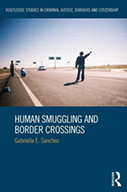Human Smuggling and Border Crossings

Author: Gabriella E. Sanchez
London; New York: Routledge, 2015. 160p.
Reviewer: Kimberly Mathis Pitts | November 2015
Media accounts of human smuggling across the US-Mexico border project the image of well-organized criminal groups who among other illicit activities, traffic migrants into the US for forced labor. “Coyotes,” or smugglers, are frequently portrayed as violent, unscrupulous, sex-crazed Mexican men who prey upon vulnerable men, women and children. Yet through her experience as a Criminal Court interviewer in Maricopa County, Arizona, Gabriella E. Sanchez became aware of the social nature of human smuggling and the sensationalization of media rhetoric. In Human Smuggling and Border Crossings, Sanchez, an anthropologist, delves into the world of human smuggling and provides an alternative reality that aims to demystify the people and process of irregular border crossings. Her study, based on court case files, interviews and participant observation, goes beyond a descriptive insight into the daily lives of human smugglers; it examines the role of the state in contributing to the criminalization process.
The implementation of strict border patrol policies and rigorous enforcement in California and Texas which aimed to reduce extralegal crossings resulted in Arizona, particularly Maricopa County, becoming the hub of irregular crossing into the US in the 1990s. Policy makers believed that irregular migrants would not risk the danger of crossing in the Sonora Desert, yet by the late 1990s, Arizona had become the main entry point for irregular migrants. The infrastructure and highway systems leading out of the Phoenix area facilitated an exit from Arizona to other states. The author argues that a human smuggling market, specializing in providing various crossing services, grew in response to the dangers inherent in crossing through Sonora. In response to becoming the new migrant corridor, Arizona law makers passed SB 1372 or the “Coyote Law” in 2005 aiming to curtail irregular border smuggling. Through an historical examination of Arizona laws, Sanchez exposes a xenophobic bias against Latinos in the criminal justice system and argues that SB 1372 not only continued an anti-immigration sentiment; it made the migrant a co-conspirator in their own smuggling. In fact, since the law was passed, the majority of the arrests have been of migrants trying to cross the border extra-legally. In an effort to reduce re-entry into the US after deportation, criminal charges punishable by imprisonment are levied upon those who clandestinely cross the border, further criminalizing them.
While not a focus of the book, the author questions neoclassical economic theories of migration which attempt to explain migration as a rational, calculated choice primarily based on the likelihood of economic gain. Through interviews with migrants, Sanchez finds that neoclassical economic and other theories of migration do not adequately capture the reality of those she encounters. Some migrants, for instance, share a desire for adventure, independence, change and personal growth. They are not pushed and pulled by the market or other forces; they are expressing their own agency in the decision to migrate.
The desire to migrate to the US combined with an increasing danger of having to cross through Sonora into Arizona, contributed to a specialized smuggling market that has been portrayed as hierarchical, highly organized, often violent and connected to criminal rings. Sanchez shows, however that while there is a smuggling network, it is linear, informal and based on trust and kinship. Furthermore, she argues, there is no particular type of person who is likely to become involved in human smuggling and border crossing. Individuals enter into various positions in the human smuggling/border crossing market because of their relationship through friendship or kinship with others who are involved and they are sought out because they have a skill or resource, such as a driver’s license and a vehicle or because they have an economic need. Despite popular perceptions, most human smugglers are employed either in the formal or informal markets and work in smuggling seasonally, temporarily or as the need arises whether economic or as a favor to others.
Many of those involved in human smuggling are themselves irregular migrants and operate on the fringe of the economy. Their role in smuggling, whether as driver, cook, house keeper or other positions, is an opportunity, albeit risky, to supplement their income. Another misperception that Sanchez attacks is the myth that smuggling facilitators are getting rich from the services they provide nor is human smuggling a full-time occupation. Considering the risk alongside the low economic return, one must question why migrants already settled in the US would take such risks to smuggle others into the country. Sanchez found that many involved in the trade do so for humanitarian reasons such as reuniting families, helping the sick and elderly get medical care, and helping victims to escape domestic violence. In fact, some involved in the market are not even paid for their services. They see their role as helping out those in need and are offended, even surprised that they are considered heinous criminals. They confided feeling a sense of personal achievement in being part of a supportive network to help fellow migrants, not unlike themselves.
To the wider publick human smuggling may seem synonymous with violence and images of migrants found dead in vans or tortured in the desert contribute to this widespread perception. Yet, Sanchez argues that violence is not inherent in the human smuggling market. In fact, she suggests that the market would cease to thrive if violence were part of the quotidian. Those seeking to cross the border clandestinely must put their trust, their lives and their money in the network that is providing services. Therefore, most migrants employ the services of those who have a reputation of providing professional services. Those employed in the human smuggling market also tend to only provide services to migrants they know personally or through referrals because of the trust in believing they will be paid for services provided. Because migrants and smugglers have to trust that each is going to provide services and fees as promised, and because of the risks both face of physical, environmental and legal dangers, violence would be detrimental to the reputation of each participant. Not only does Sanchez argue that violence is bad for business, she suggests that the social nature of the human smuggling market ameliorates the impact of violence. She further alerts the reader to another group, bajadores, crews of primarily male thieves who abduct and torture migrants in route to the US or at a safe house to hold them for ransom or steal from them. These groups often rely on extreme forms of violence and are contrary to the human smuggling market.
While this book dispels many myths about the human smuggling market, one of the main contributions is the discussion of the gendered division of labor in human smuggling. While it appears that men are more likely to take the higher-risk positions as guides across the desert and border, drivers, and facilitators, Sanchez argues that in fact the risk is much greater for women who specialize in traditionally female roles such as cook and housekeeper. Women smugglers tend to live in the Phoenix area and have longer ties to the community. Because of these ties and their more stable employment histories, women are more likely to have bank accounts and a greater financial knowledge. This, in turn, leads to them being assigned greater responsibility in the exchange of money and an increased chance of being convicted for financial crimes. Regardless of the work that women perform in human smuggling, they are paid significantly less than men, even when performing the same job, if paid at all. While many enter human smuggling through husbands or romantic partners, a number are single mothers. Unlike men involved in human smuggling, who tend to be either single or else have families living in Mexico, women are more likely to have children living in the home with them. For women who are arrested under the SB 1372 law, deportation to Mexico means not only a separation from children, who may be US citizens, and a loss of economic support, but the possibility of losing children to state custody. Men who are deported as a result of their participation in smuggling suffer a loss of income and are criminalized, but typically are reunited with family.
While there have been several accounts of border crossings, some empirical, this book is unique in the field of migration and border crossing studies in that it provides an empirical examination of smuggling facilitators. In Human Smuggling and Border Crossings, Sanchez aims to provide a view into the daily lives of those who work in the human smuggling market and show that they live ordinary lives on the fringes of legality and are not the monsters that the media would have the reader believe. She further implicates the state in not only contributing to the emergence of the market through anti-immigration policies, she places blame on the state for the dangers that migrants face not only in crossing the border extra-legally, but in their everyday lives in Arizona as they are subject to increased surveillance due to discriminatory policies.
In the process of humanizing the smuggler, through systematic examination, Sanchez has dispelled myths of the dangerous “coyote” and provided the reader with a better understanding of a complex issue. Noting that the sample size is small and that additional research is warranted, this study is a critical starting point for those who want a better understanding of US-Mexico human smugglers. It is likely to appeal to academics interested in Latin American or Chicano Studies and sociologists and criminologists interested in human smuggling and migration. It is perhaps most relevant to policy makers who should understand the latent consequences of their decisions.
Kimberly Mathis Pitts,
Assistant Professor of Sociology, Campbellsville University


